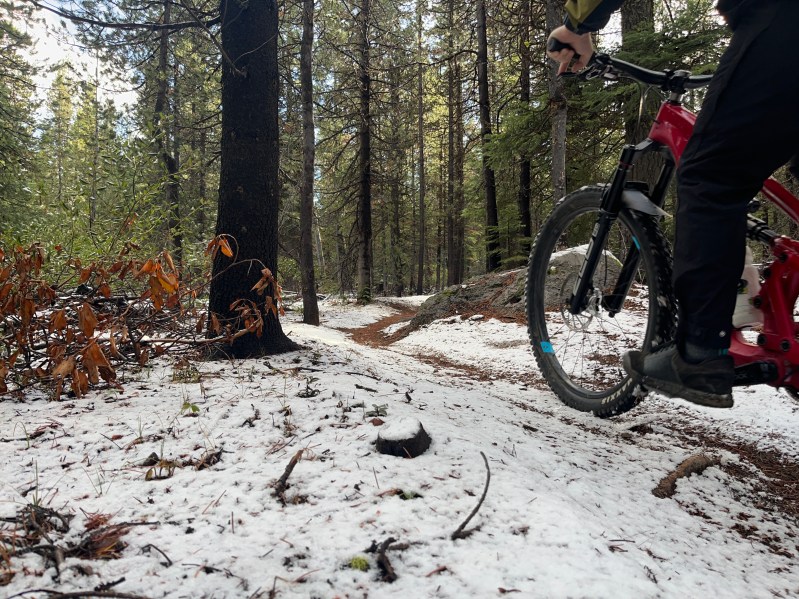
One of the best performance upgrades you can do to your mountain bike is upgrading the wheelset. Mountain bike manufacturers constantly look for ways to save money when building bike builds. Bike wheels are one of those money-saving components.
When upgrading your mountain bike or mountain biking gear, you are looking for upgrades that will give you noticeable performance increases. This is especially true the more expensive the upgrade is.
So, if you are going to spend a few thousand dollars on one upgrade, like bike wheels, then that wheelset better perform pretty damn well.
I expected this when I received Forge + Bond’s new 30AM wheelset to test and review. Knowing this was a higher-end carbon wheelset, I expected higher-end performance.
And that is precisely what I got.

Why carbon?
Forge + Bond as a company has been around for just about one year. They broke onto the scene last spring, offering two different carbon wheelsets on opposite ends of the spectrum. Their gravel bike wheels were on one end, and an enduro/DH wheelset sat on the other.
Then, several months later, they introduced their newest offering, the 30AM. This jack-of-all-trades carbon wheelset fits comfortably in the “trail” category of mountain biking.
So, why would someone choose a carbon wheelset for their mountain bike? Mountain biking with a high-end carbon wheelset should leave the rider feeling a few different ride characteristics, which I wanted to experience.
First, carbon bike wheels should damp trail feedback. Carbon typically absorbs trail chatter better than aluminum. I was anticipating feeling less trail vibrations than on my aluminum wheelset.
Next, carbon tends to be much stiffer than aluminum. This stiffness can especially be felt in the corners, as the wheels flex under the pressure of your body weight in the corner. But, carbon can sometimes be too stiff, giving the rider a harsh ride as they ping and bounce off every rock and root.
As I tested the Forge + Bond 30AM carbon wheels, I hoped to experience wheels that were stiff enough to hold a line in the corners but not so rigid that they rode harshly.
Lastly, when upgrading our mountain bike with a set of carbon bike wheels, we usually hope they are lighter than our current wheels. Saving weight is excellent; lighter usually means bike wheels can spin up faster.

Forge + Bond 30AM first impressions
Honestly, my first ride impressions of the Forge + Bond 30AM wheels were that they were okay—just okay.
Yes, they damped trail chatter and were stiffer than the aluminum wheels I had just been on. They were also lighter, but the weight savings were about one pound—nothing outrageously significant.
Don’t get me wrong; they were all around a better wheel than the wheels I had been riding. But, for more than double the price of my aluminum wheels, the “price to performance” ratio wasn’t adding up in my head.
That was until we finally got some moisture in the ground. Summer hung around for the first several weeks that I was riding the Forge + Bond 30AMs. This meant very dry, dusty, sandy trails in my area—all-around lousy trail conditions. But, once it rained, the wheels came alive.
I first felt the incredible stiffness of the 30AMs riding a trail after a series of fall rain showers. This backcountry descent drops 1000 ft, creating high speeds over chunky roots and rocks. The corners are relatively flat except for the ruts eroded into the trail. These ruts help you carry speed down the track.
And that is exactly what happened—not only did I maintain speed through these rutted turns, but I found myself gaining speed as I exited. I stayed off my brakes nearly the entire time. The difference? I was fully trusting in the stiffness of the 30AMs to hold the line I was in.
It is common sense that we have to slow down in corners, but we usually slow down too much. We do this because we feel our wheels flexing in the corners. And while a bit of flex is okay, too much can have you feeling unstable. You feel the flex, panic, and, thus, hit the brakes.
The Forge + Bond 30AMs have the perfect amount of stiffness and compliance, perfectly holding the line I need without feeling harsh. And, if I needed to get out of a particular line, I once again found myself trusting the wheels, pushing into the bike, and popping out rather than touching the brakes. The wheels held better than I have ever experienced.
Mountain biking chunkier tech trails also showed the performance of the 30AMs. Once again, I found myself going faster and faster as the wheels did an excellent job absorbing the feedback and chatter of the trail.

Pros and cons of the Forge + Bond 30AM wheels
The more I rode the Forge + Bond 30AM wheels, the more I realized how good they were. While many things made the wheels phenomenal, there was one thing that I have to mention as a setback.
Cons
I have nothing negative to say about how the Forge + Bond 30AM wheels performed. Truly, they are the best wheels I’ve ever ridden. But, with high performance comes a high price. The wheelset I opted for will set you back $2200.
Yes, this is more expensive than some entry-level mountain bikes. You can save a few hundred by choosing different hubs, but you still pay nearly $2000.
Pros
These wheels checked off everything on my list. They were lightweight, stiff, and absorbed trail chatter. But, the major standout of the 30AMs has to be how Forge + Bond found the perfect balance of stiffness and compliance.
The wheels held corners better than any other wheelset I’ve experienced. This, in turn, created confidence, allowing me to push harder, ride faster, and stay off the brakes more.
Lifetime warranty. For $2200, I expected the wheels to perform as well as they did. Forge + Bond believes in the quality performance of their wheels so much that they are willing to back them up with a lifetime warranty.
Usually, “manufacturer defects” are where a warranty stops. Forge + Bond went further, protecting against any damage to the wheel from mountain biking. Forge + Bond states in their warranty information:
Let’s make this easy. If you buy a set of our wheels brand new directly from us or from one of our authorized retailers, or they come as original equipment on a new bike you buy, they’re covered by a lifetime warranty…In the event you crack one of our rims during normal intended use, we’ll replace it for free.
You break them, they buy them.



